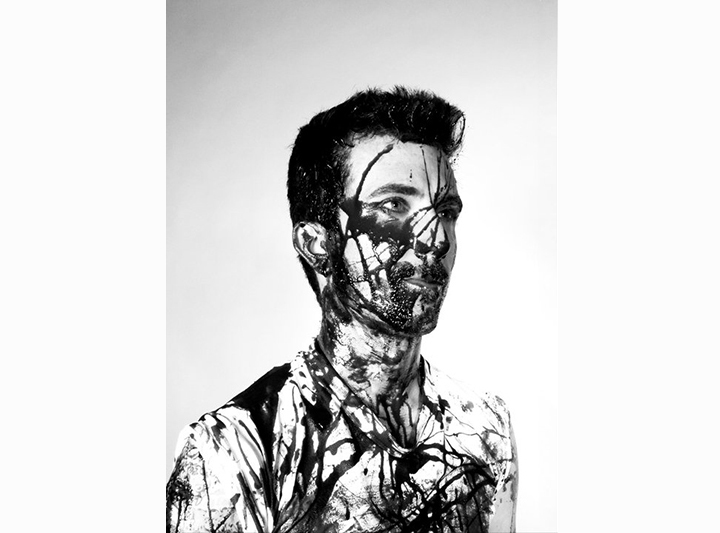2011 - Sparagmos and Omophagia : Gallery 123, George Mason University, Fairfax, VA.
Sparagmos: the tearing to pieces of a live victim, as a bull or a calf, by a band of bacchantes in a Dionysian orgy.
Omophagia: the eating of raw food, especially raw meat.
Note: this text was originally written in 2011. While I still think we continue to live in a dangerously context free simulacra, my feelings about the gay community have evolved and are much less cynical. I still see the warning signs, but I think I am now much more sympathetic to our postmodern plights than I was initially. Perhaps because, as my younger self will explain, those plights still thrive inside each of us.
For the series Sparagmos and Omophagia, I take on the identity of Sebastian Venable from Tennessee Williams' Suddenly, Last Summer. Using elements from both the play and the 1959 movie of the same name, I explore the psyche of Sebastian. In both the play and particularly the movie, Sebastian is vilified, albeit without a voice or a face. So I in turn give him my own while using his identity to explore darker aspects of gay culture that I see in and around me.
Using the projection on screen in the middle as reference, these shots show the installation as a whole. That projection is a PSA from the late 1950's called "Boys Beware." In it, a policeman warns the male youth of the day to beware of the homosexual on the prowl. In the background are a series of prints that combine digital printing, gum bichromate and cyanotype. Also displayed throughout the installation are several 4" x 6" mini LCD screens with looping video.
Installation shot 1.
Installation shot 2.
Boys Beware (1961)
In mythology, the ouroboros is a serpent who devours itself by eating its own tail. It can symbolize many things, one being everlasting re-creation. Another meaning can be total consumption, even to the degree where one consumes themselves. In the case of Sebastian Venable, it can show how we feed and are fed upon by popular culture and media, all the while we consume and are consumed. After all, in "Suddenly, Last Summer," Sebastian is very much consumed - quite literally: Sebastian is torn apart and devoured in the street - cannibalized by what he desires. An appropriate metaphor.
Ouroboros
Stills from taped Performance.
2011
In a series of digital stills, I further explore the identity of Sebastian Venable, while shown with the character of Catherine Holly. In the play and the movie, Catherine is Sebastian's cousin, whom he uses to "procure" young men to him, i.e. he uses her beauty to lure sexual in his conquests. Catherine beings unknowingly procuring for Sebastian, though she realizes what is happening as the narrative progresses. In the film version of Suddenly, Last Summer, there is an iconic shot of Catherine (played by Elizabeth Taylor) sitting on a beach, right after she begins to discover what Sebastian is using her for; Sebastian forces Catherine into the ocean while wearing a white bathing suit, knowing that when she gets wet, the suit will become transparent. In turn, the local male youth flock to Catherine to get a glimpse of her semi-nude body appearing from beneath the fabric. One image is meant to recreate that scene, while another means to recreate one more iconic shot from the film, as Catherine looks up at Sebastian from the same beach. It is a display of manipulating the gaze, as well as a play between who the dominant character is. The viewer is forced to have Sebastian's gaze instead, pulling the focus up from Taylor's Catherine back to Sebastian. However the waters are muddied by the sexuality of both characters.






Something Evil dot gif
Catherine Screaming 1
Catherine Screaming 2
The night before he shot Congresswoman Gabrielle Giffords, Jared Lee Loughner dropped off a roll of film to be developed at a local Walgreens. In those photos, Loughner posed with the Glock 19 that he would later use in the Arizona Massacre, all while wearing nothing but a red thong. He placed the gun against his crotch and buttocks, using the weapon as a highly charged, sexualized item. Twenty-four hours later, he would commit the Arizona Massacre with that same weapon. This sexualization of violence both plays into Sebastian's own self-destructiveness while commenting on an ever increasing notion of that which has permeated American mass media.
Self Portrait as Sebastian, After Jared Lee Loughner
Series of 4" x 6" Photos from Disposable Camera
2011
Along with these series of photos is a mini LCD screen that has a video taken from Bruce LaBruce's 2004 movie, The Raspberry Reich. In it, a man is engaging with a firearm, treating it as a phallic object by performing fellatio on it and touching it erotically.
Self Portrait as Sebastian, After Jared Lee (Installation Shot)
Approx. 8' x 8'
Series of 4" x 6" photos, Mini LCD Screen wity looping video
2011
The Raspberry Reich (Sparagmos & Omophagia Edit)
So through all of this, I struggle with Sebastian living inside of me. His demons are also mine, and we both search for meaning in the things we see and we find it where we can. He finds it through sex, and perhaps the chase that ensues when he used his mother or cousin to lure boys to him. Having the whole notion of being gay built up around how one has sex, I can't help but sympathize with this, as sex is indeed a way of identifying and connecting with others. It's such a strong connection that he was willing to do whatever it took to feel it. We live our lives as sexual creatures, who continue to be repressed to the degree in which one must find an outlet by any means necessary. This is a struggle I see the gay community around still battle.
Because of the relationship I had with Sebastian, I decided to change his fate: instead of Sebastian being cannibalized in the street by the youth whom he desires, I instead had Sebastian do the killing. For one, it seemed more sad that way. And two, it showed how Sebastian is really incapable of getting what he wants. Out of desperation, he goes after his desires with full force and the only way he can get fulfillment out of them is by consuming them. It is an exploration into how one does not have to die to be eaten alive and how consumption of the media can in turn devour ones identity.
Untitled (Sebastian and The Procured)
Video still from performance
2011
Lady Gaga - Paparazzi ( Sparagmos & Omophagia Edit)
Living in a post-Postmodern world, societally we are consuming these images that are void of their original content. Lady Gaga covers herself in blood and a news report comes out that some girl in Oklahoma killed her cat so that she could wear it's blood to Gaga's concert. RollingStone just published a report on the mental health of some military soldiers serving in Afghanistan and the sport killing of Afghan civilians, while they play Call of Duty in their barracks. The issue of war aside, the content we consume in the media is fed to us like it is original content, when in fact it is imagery that has been recycled ad nauseam, to the point where we are viewing this content without any context.
Death of Sebastion dot gif
Sebastian then dies as a Frankenstein character, a monster created by the culture that destroyed him.
But imagine that these characters are not so disturbed, but that they are men with no other options. They see ways of escaping their representation through media and they then take action, building their identity on images they see, not knowing how or why those images developed. The Sebastian that lives inside of me sees theres things and identifies with them, realizing that he can use those same outlets to bring about a fulfillment that he cannot find anywhere else. He uses a friend to get close to someone and yet is inept at actually building that relationship. He then bridges that void using the only means he knows. He sees violence as sexual expression and he is unable to differentiate the two. Because of the media's display of image with no context to content, like the sociopath that he is, he is unable to connect true emotion with the acts he carries out. Because he is not trained to closely investigate the origin of that which he consumes, he ends up consuming all - including himself. He is a grotesque metaphor for something that we each have the potential to be.
Self Portrait as Sebastian, after Dexter.
Digital Photograph
2011
Self Portrait as Sebastian, after Mishima, after Sebastian.
Digital Photograph
2011
Resources:
• Why is it always a white guy: The roots of modern, violent rage (via Salon)





